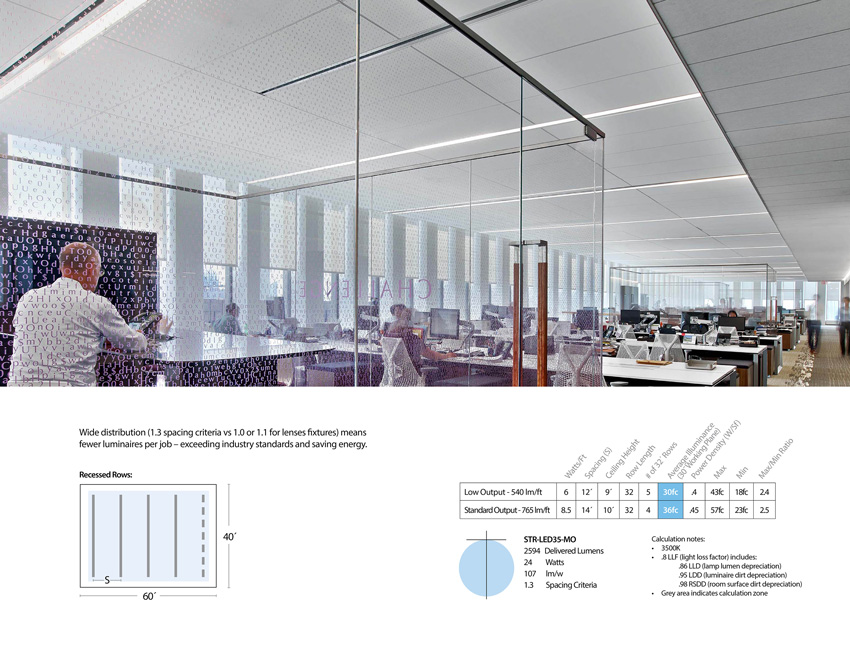Linear Lighting Frenzy
The lighting industry continues to seek inventive ways to make light more efficient and ultimately more appealing to vastly improve the user experience
![]() Continuing Education
Continuing Education
Use the following learning objectives to focus your study while reading this month’s Continuing Education article.
Learning Objectives - After reading this article, you will be able to:
- Explain how the drivers in the lighting specification process vary by the role of each key decision maker.
- Elaborate upon key trends in LED linear that are flourishing right now and their impact on the user experience.
- Describe the artistic inspiration behind veiled ambient lighting, its widespread aesthetic appeal, and how it’s enhancing the user experience.
- List two of the next wave of technological advances in LED linear lighting.
Inspiration can come from many places, and for lighting, it only makes sense that those seeking new revelation would turn to the sky. Consider the work of American artist James Turrell, globally renowned for his interpretation of light, space, and playfulness in terms of perceived reality. He fancies the sky his studio, material, and canvas—creating a trompe l’oeil effect where he figuratively “drops the bass” on depth perception. As Calvin Tomkins of the New Yorker once said, “His work is not about light or a record of light; it is light—the physical presence of light made manifest in sensory form.”
Captivated by this concept, fixture designers found a way to reinterpret what Turrell was doing in the art world in a way that was commercially applicable. Dubbed “veiled ambient” lighting, it’s a brilliantly minimalist breakthrough that enables light channels to visually recede into the ceiling, virtually disappearing. The illumination is present, but the source is barely perceptible. Jon Steele, GM of Prudential Lighting, pioneer of this emerging design, commented on the inspiration behind the concept. “We wondered if there was a way to pump light through channels that felt like daylight on a cloudy day, with no shadows or sense of source. We accomplished this through incredibly uniform indirect lighting with a ‘forever’ look that appears seamlessly integrated into the architecture.”
To fully appreciate the magnitude of this breakthrough, it’s important to understand how long it has taken for the lighting industry to truly flourish in the innovation arena.
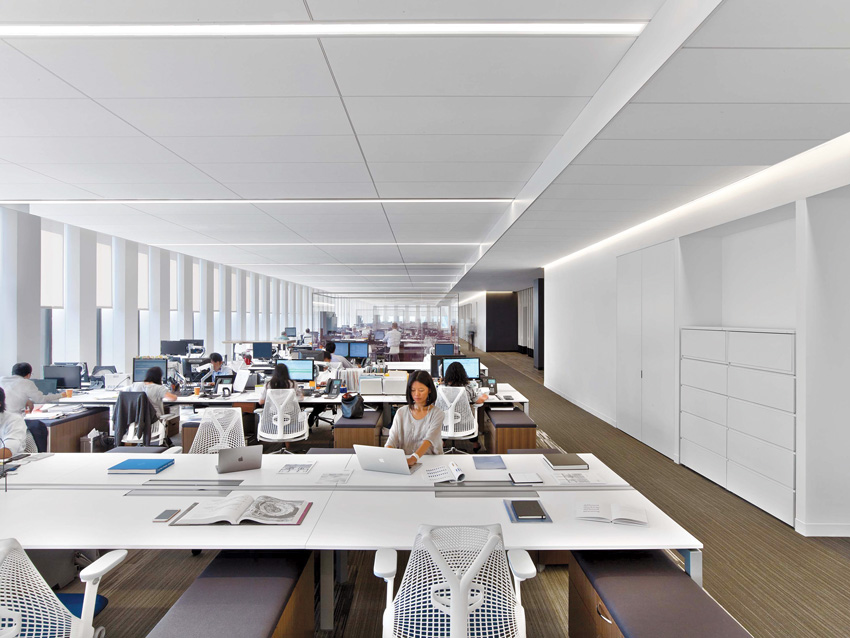
All images courtesy of Prudential Lighting, except as noted
Veiled ambient lighting, with no lenses or seams, emanates more like cove lighting or sunlight funneled through the architecture than typical lensed linear fixtures.
Architect: Larry Marner Architects
Lighting Designer: Kugler Ning
Linear Lighting: From Fossil to Fast Track
Over the past several decades, while nearly every other building material continued to evolve, becoming stronger, smarter, longer lasting, and more cost efficient, lighting didn’t have much in the way of newslworthiness—until now. These days, lighting is making up for lost time at an incredibly accelerated pace—particularly linear lighting (those long, narrow fixtures you see in nearly every commercial environment).
Thanks to the emergence, explosive growth, and continual fine-tuning of LED, lighting has seen more momentum in the past decade than the previous five decades. Given all those years of lackluster history, this momentum has the industry understandably abuzz. Granted, many of the first few breakthroughs were primarily designed to improve energy efficiency and extend life, but significant strides in form factors for aesthetics, light optics, adaptability, and control are making headlines as well. The term “form factor” encompasses the variety of fixture shapes and sizes available for specification.
The History of Linear Illumination
Linear lighting appeared on the scene as early as the 1950s as an alternative to recessed rectangular troffers in modular dropped ceilings, and it was immediately embraced. Originally introduced by Samuel Herst of Peerless Lighting, linear direct and indirect lighting struck a chord within the design community. It created intrigue with its long lines of light, and over the years, it has established itself as the “Class A” luminaire—catapulting in popularity to become the go-to for architectural lighting.
A myriad of linear form factors evolved from the 70s through the 90s, and linear gradually replaced millions of boxy square troffers in offices and classrooms. With the rise of desktop computers in the 90s, screen glare became a concern, screen glare became a concern so louvers were implemented to minimize the way the light bounced off the shiny screens. Indirect and direct/indirect lighting also became far more popular in an effort to reduce glare on computer screens and offset the cave effect of louvered troffers. Then in 1995, the introduction of the T5/HO lamp allowed for smaller form factor, higher lumen packages, and increased optical control.
The early 2000s brought the introduction of recessed linear lighting as a companion to direct/indirect pendants to create complete systems. The response was phenomenal, and linear lighting became the norm for commercial lighting, increasing demand for innovation. The industry quickly responded with different form factors and apertures, patterns, and improved optics. One noteworthy breakthrough in the mid-2000s was the development of “batwing” film, which enhanced linear distribution, allowing for wider spacing of fixtures (12-foot spacing instead of the typical 8-foot or 10-foot), ultimately reducing materials and labor costs while also saving energy. But the technology itself hadn’t improved. They were essentially the same fluorescent lamps people were using back in the 1950s even though we were well into the 2000s. They had mediocre optics, dimming was expensive, and form factors were large. Thankfully, change was imminent.
The LED Revolution
As LED light sources became more affordable around 2010–2012, a retrofit situation emerged for the sake of speed to market. Manufacturers were simply giving their old fluorescent fixtures new LED arrays, instead of reimagining how fixtures could play to LED’s unique strengths. The result? Longer life, improved energy efficiency, and less maintenance—but little or no improvement in form factor freedom or optical control. Bothersome striations, dark spots, and screen glare continued to plague office workers.
A 2014 Professional Lighting Designers Association (PLDA) survey reported that a shocking 47 percent of lighting designers citing a need for glare reduction—their top concern.1 Specifically, participants in the study cited frustrations due to dim areas, overly bright work stations, and glare on computer screens. Similar studies going back to the 1990s and early 2000s conducted by global interiors giant Steelcase and Interior Design Magazine point to lighting as the primary source of frustration with work environments.2
What’s to Blame?
Common problems included too little or too much light, glare on shiny computer screens, and dark walls and ceilings creating cave-like effects and causing employee eye strain for extended periods of time. With the recent LED revolution, manufacturers scrambled to respond to demand, jamming the compact, precise, directional LEDs into linear fixtures designed for fluorescent lamps. Glare issues often worsened with exposed LEDs or light spilling out in harsh direct light.
Additionally, fixtures were not delivering on the manufacturers’ claims in terms of lumen output—the dimming systems were not smooth or subtle, and the light was often far too bright for the environment. There were also some challenges with maintenance and field replacement. All in all, the transition from fluorescent lighting to LED was a bit of a “two steps forward, one step back” process as lighting evolved into a viable technology industry.
The Ideal Luminaire Look
The conversion to LED was so fast and furious in the industry, few stopped to ask the critical questions: What would the ideal luminaire look like? What do the end users desire in their workplaces, schools, etc.? Part of the complexity of these questions is that the answers vary by audience.
The architect or interior designer is often looking for the fixtures to disappear, recede into the architecture, and not interrupt the lines and flow of the space. They want to see light, not light fixtures. Their dream would be to eliminate those seams and clunky lenses that trap dirt and bugs, crack and leak light, and generally distract from the architecture. The ideal lighting would be sunlight pouring through the architecture into every interior space, with no light fixture clutter, just soft glowing light—think cove lighting.
The lighting designer/engineer focuses on the quality of light, enhancing the experience with vertical illumination (lighting walls and ceilings), creating soft, even light across the working plane, limiting glare, and of course, managing energy code and safety requirements.
On the flip side, the contractor simply wants fixtures that install easily. Fast, cheap, and “good enough” might well be their unofficial motto. There’s typically pushback on fixtures that take longer to install, costing more than they originally estimated. They sometimes create problems by substituting less-expensive, lower-performing fixtures in place of those that have been specified by interior or lighting teams—so simple installation should be a key consideration in the new product development process.
The building owner is looking for a bit of everything: stunning aesthetics, smooth installation, easy maintenance, energy efficiency (lower watts per square foot), and lower overall cost.
Maintenance teams have a similar mindset, and prefer low-maintenance fixtures and easy field replacement.
And finally, end users want a better experience: beautiful, soft light, simple, intuitive controls, and no glare. They want to enjoy the spaces where they work and play.
Where’s the Common Ground?
The quintessential illumination effect is subtle, with a soft, uniform, highly efficient glow of light—like sunlight filtered through the structure into the architectural space. It has no seams or glare so the focus is on light, not light sources. It’s energy efficient, simple to install, and easy to maintain. As humans, we are vertical creatures, so illuminating walls and ceilings is essential for avoiding depressing cave effects. Improved work environment has an impact on employee productivity, and research has shown even a 1-percent improvement in employee productivity has significant financial benefits.
These are exciting times. Here’s what’s currently trending in linear lighting:
- Optics (controlling light distribution)
- Miniaturization
- Organic form factors (curvilinear)
- Hidden light sources, which we will call “veiled ambient”
- Technology leaps from IoT to controls integration
- Tunable white or circadian lighting and tunable color
Dramatically Improved Optics
Statistics indicate that lighting is the biggest power drain in an office building, accounting for a mind-blowing 29 percent of the energy consumed.3 There’s lots of talk about LED efficacy with organizations like Design Lights Consortium (DLC) driving energy rebates with their fixture listings, but efficacy is only part of the equation. The most efficient fixtures do not necessarily make the best or even good lighting, nor do they even lead to the most energy efficient spaces. The end goal is using less energy in our workplaces and schools, and that can be partly achieved by controlling the light, directing it where it’s needed, thereby lowering energy demands by using fewer fixtures.
We also need to consider the human part of the equation. Lighting is ultimately for our benefit, and when we enjoy our workplaces, we tend to be more productive. The Illuminating Engineering Society (IES) offers lighting criteria for making lighting safe, pleasant, and efficient, but if we only follow the letter of the law in meeting foot candle requirements and don’t consider the light’s actual effectiveness in its environment, we are missing the intention driving the IES requirements. When efficacy is the primary or sole consideration for evaluating the performance of LED luminaires, it undermines the power of control, and ultimately, the light distribution suffers, negatively impacting the quality of the user experience.
For example, consider open office and classroom lighting needs. Two main issues lie in problems caused by static light distribution that’s either too high or too tight. If the distribution is too high, wasted light spills where it’s not needed, essentially becoming “light pollution,” causing glare and requiring more lumens to reach optimum light levels. However, if the distribution is too tight or contained, it results in hotspots beneath the uncontrolled sources, requiring more fixtures to even it out—ultimately resulting in escalated material and installation costs and higher site wattage.4
Think About Irrigating a Garden
To better understand the power of optics, consider a meticulously maintained botanical garden. Each variety of plant differs in the amount of water it requires, so a somewhat haphazard blasting from wide-open, full-circle sprinklers isn’t going to cut it. There’s an excessive amount of waste, and the plants aren’t getting what they need. Instead, each sprinkler needs to be placed with precision (with appropriate nozzles chosen to control where the water is directed—quarters, halves, and fulls for lawns, thin side strips for planters, and bubblers or drip for trees, with the output calibrated for the particular plant it’s watering, conserving water and giving each plant or tree the optimal amount of water, not too little or too much.
The same is true with light, both to lessen the amount of light wasted and to improve the human experience, whether that be even distribution over workspaces or selectively focused to enhance the drama of the space’s architectural features (walls and ceilings) with asymmetric and cove lighting.
Historically, optic design was achieved for fluorescent lights with the use of clunky mechanical kickers or a one-size-fits-all optic film with mixed results, often resulting in big efficiency drops and poor control. Now, with tiny LED light sources, light can be more controlled. Lens refractor technology shapes light in new and powerful ways while maintaining high levels of efficacy. Developed by lighting physics gurus and engineering wizards, this design coup has transformed the lighting experience. Lenses are no longer simply frosted acrylic. They can be engineered to map each ray of light to create more precise illumination patterns in the desired shape: batwings for open office, and asymmetric wall washes and grazes for vertical surfaces.
Batwing for Open Office and Classrooom Lighting
Often, office lighting is poorly designed with uneven distribution of light. There’s too much light directly below fixtures and not enough in between them. This is because most linear and troffer fixtures distribute light in a narrow ellipse shape, where the batwing shape is far more ideal, distributing light more evenly across the working plane. Batwings also allow for wider spacing of fixtures. Eight-foot or 10-foot spacing between linear fixtures has been the norm for decades, but batwing distributions allow for 14 feet or even 16 feet between fixtures.
That extra 4 inches in the spacing results in about a 30 percent savings in fixture and installation costs in large open office or classroom spaces, with similar energy savings as well. First-generation LED batwing lenses had unattractive technical looks, but new laser-engraved batwing lenses are far more aesthetically pleasing, with the soft, smooth frosted look of typical open office lighting. Batwing distributions also reduce eye strain since minimal light is thrown up into the glare zone (above 65 degrees where light reflects off shiny computer screens).
Figure 1 shows a foot candle comparison. A foot candle is a measurement of light intensity and is defined as the illuminance on a 1-square-foot surface from a uniform source of light. The wide, even distribution of light from batwing optics allows for wider spacing between fixtures than typical LED satin lens linear fixtures, while still producing a more uniform glow across the work plane (indicated by the space inside the gray bars). These fixtures are spaced 12 feet apart. The batwing has much more even light distribution than typical linear fixtures with satin lenses, as can be seen by the foot candle distributions and Max/Min in the lower left (a lower Max/Min is better).
Notes:
- 3,500 K at 4.5 watts/foot direct only
- 12-foot spacing between fixtures
- 9-foot ceiling
- Foot candles at working plane
- 0.9 LLF
Note: while batwing distributions are ideal for open offices or classrooms, or individual offices, they lose effectiveness with high cubicle walls that block the light.
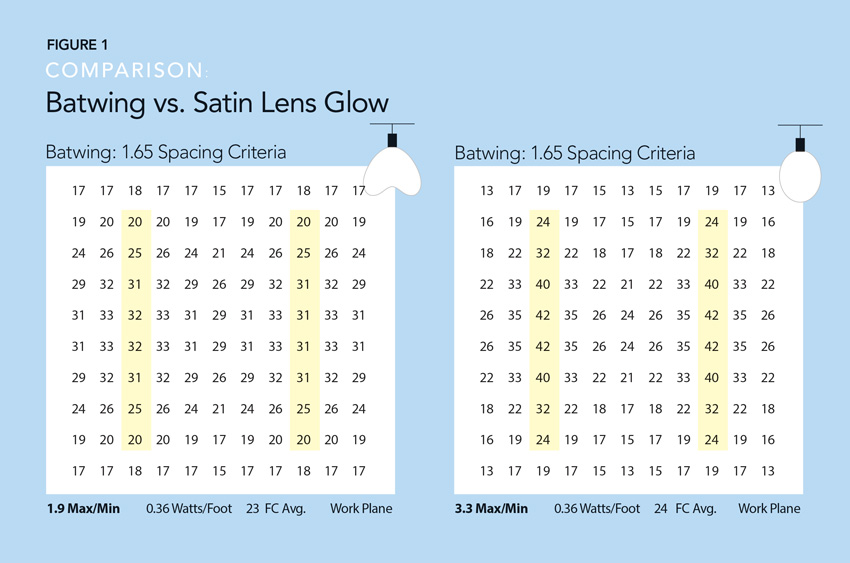
Room application batwing vs. typical satin-lensed linear fixture comparison
Uniform Ceilings: Indirect Extreme Batwings or Ceiling Washes
The 1990s computer revolution brought about the evolution of indirect illumination. Bouncing light off ceilings and walls creates less glare on shiny screens and veiling reflections on paper tasks. However, LED lighting took a small step backward with tiny LED arrays pointing too much light directly above the light fixtures and not enough across the ceiling plane, leading to stripes along ceilings. What’s the solution? Wide, even, indirect light, extreme batwings, or ceiling washes with broad, low-angle beams casting wide, indirect uplight and creating beautifully uniform ceilings with minimal glare. Ceiling wash optics also allow for linear fixtures to be installed closer to the ceiling. Eighteen to 24 inches is typically recommended, and a good ceiling wash will illuminate ceilings far more evenly compared with generic indirect LED lighting. Ceiling washes not only reduce glare, but they also reduce the cave effect and provide a more comfortable vertical illumination (mimicking the outdoors).
Figure 2 shows a comparison of a linear indirect ceiling wash optic vs a typical LED indirect fixture with a glow of light that often creates zebra-like stripes on the ceiling—way too bright above the fixture and too dark in between fixtures. Ceiling wash optics offer a significantly more even glow across the ceiling (indicated by the space between the gray bars indicating linear fixtures). Ceiling washes provide far lower variation in light levels than typical symmetric glow fixtures. For comparison, see the dramatically different Max/Min range at the lower left of each chart.
Notes:
- 3,500 K at 4.5 watts/foot indirect only
- 14-foot spacing between fixtures
- Fixtures hung 18 inches below ceiling
- Foot candles on ceiling plane
- 0.9 LLF
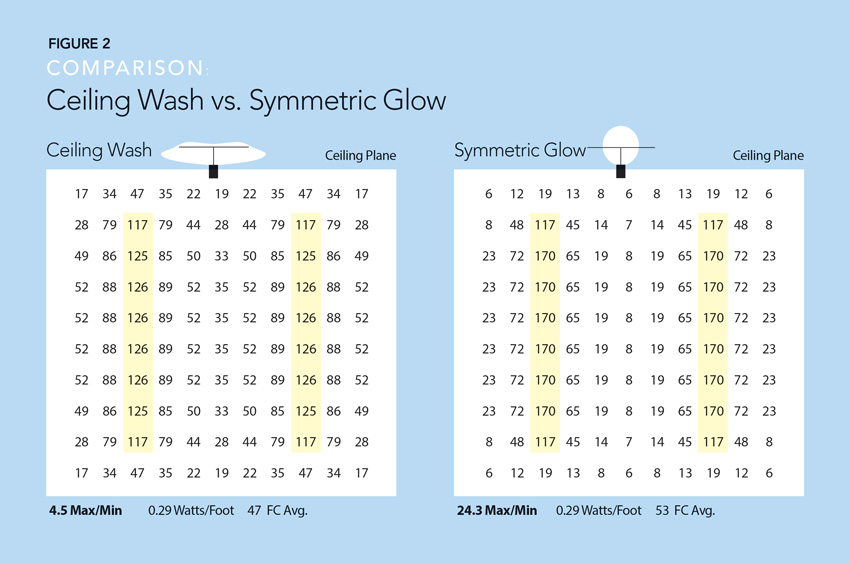
Ceiling wash room application vs. typical indirect glow comparison
More Control: Adjusting Direct and Indirect Independently
Some direct/indirect fixtures have LED arrays installed horizontally to achieve a ceiling wash effect but do not allow users to control direct and indirect light separately. When occupants dim the direct lighting, the indirect dims as well. For AV projection and other applications, separate control is preferred, where direct lighting can be dimmed or turned off while the uplight is left on to illuminate the space enough for note-taking. Separate dimming is also desirable to adjust for daylight changes, saving energy and vastly improving the user experience.
Vertical Illumination Creates a More Robust Palette
As vertically oriented creatures who are accustomed to our primary light source (the sun) creating bright skies, we desire vertical illumination indoors as well. Unfortunately, budgets seldom allow for the involvement of lighting designers trained to create meticulously lighted spaces where wall/ceiling illumination is a key component. These new optics-driven, energy-efficient options from wall washers to grazers provide far more visual continuity, particularly in open office environments. Depending on the need, lenses are crafted to spread the light in a wider distribution or concentrate it to highlight a focal point, all achieving uniform illumination without the striations and hot spots of the previous iterations.
Wall Wash Bathes Walls with Light, Highlighting Artwork
Our workplaces need vertical illumination to bring our eyes up, but asymmetric lighting has typically been highly inefficient, difficult to control and expensive. The wall wash is an application that enhances artwork or simply the wall itself with a dimensional effect, drawing the eye to the focal point with just the right amount of highlight, while flattening the appearance of the wall.
Wall washes are typically placed 18 inches to 4 feet away from a wall surface; in some cases with taller ceilings, they are a bit further away from the wall. It’s a subtle effect that piques visual interest without disrupting the balance of the vertical plane.
LED optics now eliminate the need for unsightly mechanical kickers and open cavities. These smarter new fixture designs reflect a significant amount of the emitted light instead of absorbing it. Instead of bouncing around inside the fixture, the light is directed out in a controlled manner. Just a few years ago, asymmetric wall wash luminaires were typically 40 to 50 lumens per watt (lm/w), but they now are more often 80 to 100 lm/w with smoother distribution of light as well.
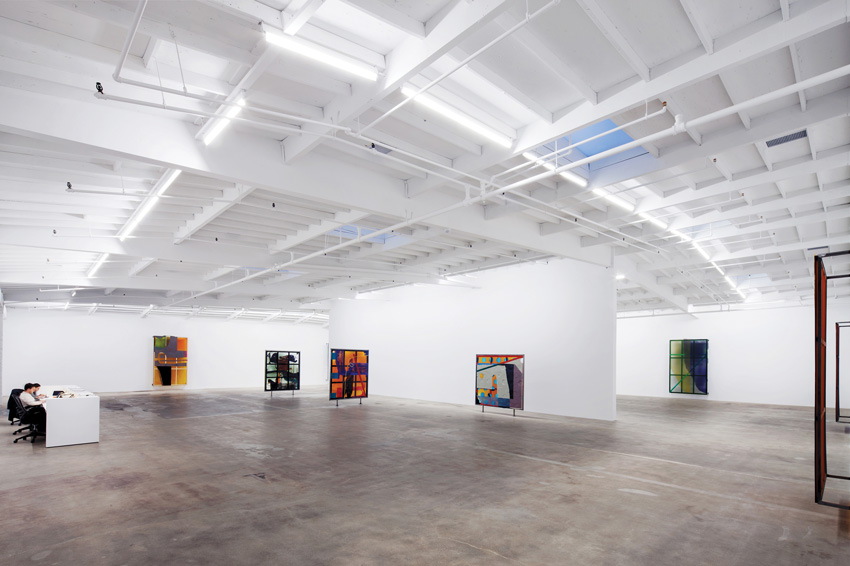
Photo: Kelly Barrie Studio
A small but powerful linear wall wash was utilized for this art gallery where the fixtures were mounted 20 feet high and 8 feet away from the walls—and provided beautifully lit walls along with soft, even general illumination (IES award winner).
Architect: Standard Architecture
Lighting Designer: Kugler Ning
Photographer: Kelly Barrie Studio
Tight, Focused Wall Grazer Beam Brings Out Architectural Features
In scenarios where there’s a textural wall detail to be highlighted, the wall grazer evenly illuminates and accents key details. Typically placed flush to the wall, the wall grazer visually widens the space, elevating the visual drama of details from natural materials like brick or stone, or any type of tinted or textured architectural accent. Linear LED wall grazing has usually been achieved only in recessed or regressed fixtures because of the way discrete optics were mounted to LED strip lights, but suspended and wall-mounted wall grazing is now easily achievable.
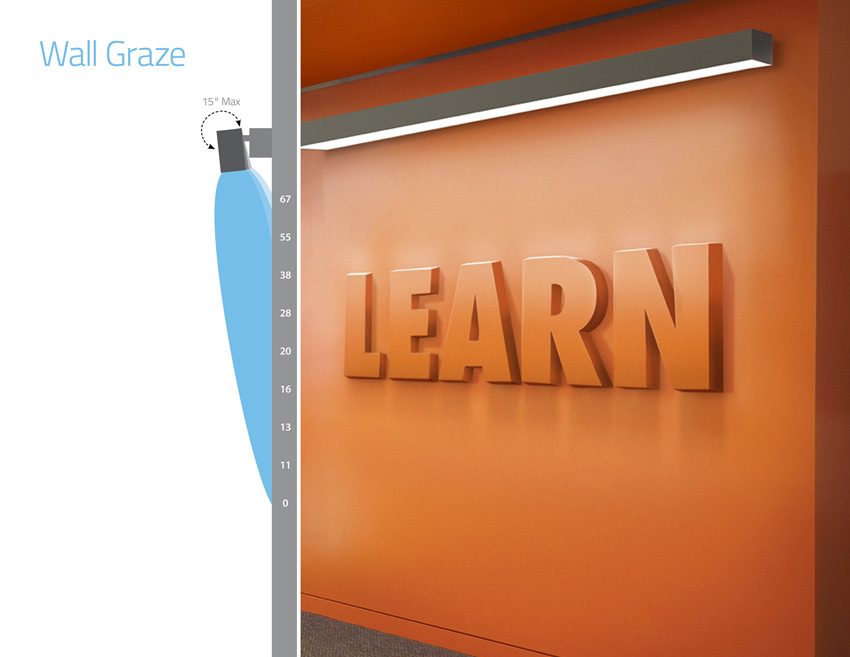
Photo rendering of a wall mounted wall grazing fixture with foot candle distribution down the wall
Perimeter Fill: Ideal for Hospital Hallways
A new optic, the powerful perimeter fill is superior to traditional perimeter fixtures for washing hospital corridors in light. Its outstanding distribution qualities allow it to illuminate 8-foot-wide corridors from just one side instead of the typically inefficient cove or perimeter lighting needed along both sides. The perimeter fill optic results in cutting the necessary number of fixtures by 50 percent for significant savings in both energy and materials costs.
Froedtert Hospital in Wauwatosa, Wisconsin, installed fixtures with perimeter fill optics along one side of its corridors, meeting the stringent 50 foot candle requirements across the entire corridor and reducing the number of fixtures needed by half.
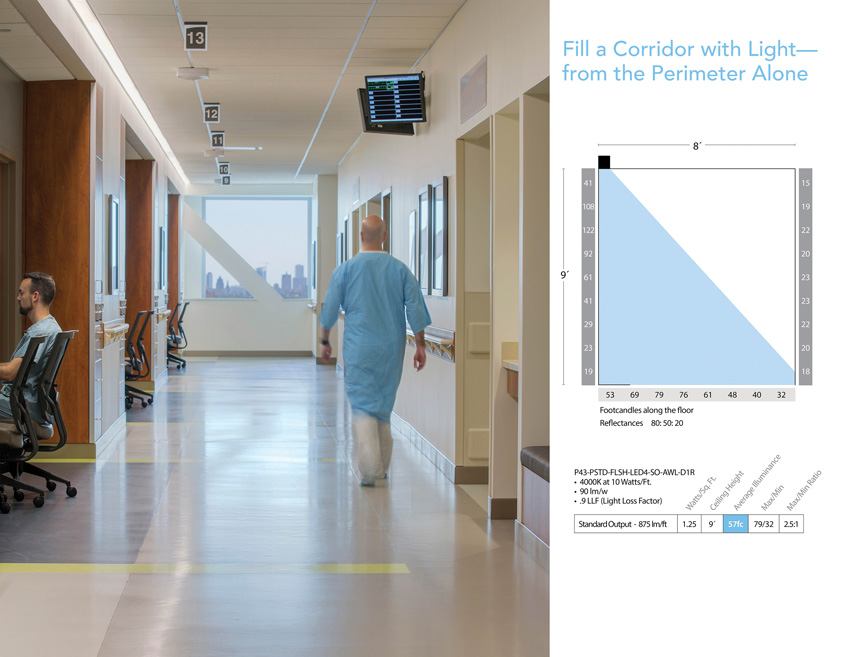
Photo: Tom Rossiter
Froedtert Hospital perimeter fill optic illuminating an 8-foot-wide corridor from one side of the perimeter and the foot-candle calculation for this project
Architect: Cannon Design
Photographer: Tom Rossiter
Linear LED fixtures that offer perimeter fill distribution patterns are available in recessed and wall-mounted configurations, in 4-inch and 2.5-inch apertures. The wall-mounted fixtures are also available in models that provide indirect illumination as well, washing the corridor ceiling in light and enhancing the overall glow.
Scaling Down with Miniaturization
In the days of fluorescent lighting, 6-foot and 4-foot apertures were the most common linear apertures, with 2.5 inches being about the smallest possible. But because LED is a much smaller form factor, lines of light as narrow as 1/2 inch have become available. So these sleek, minimal lines of light can become an engaging graphic element, especially in combination with the organic curvilinear trend. The downside is their limited light distribution, which means foot candle requirements often cannot be met without using significantly more fixtures or pushing so much light that the fixture becomes too bright and a source of glare. So while the creative possibilities are intriguing, attempting to illuminate commercial spaces with apertures smaller than about 2 inches remains challenging, even with tiny LED light sources.
Dialing Up the Whimsy with Organic Form Factors
Playful, curvilinear shapes are appearing more frequently, from donut-shaped Os to gentle arcs of light. A purely aesthetic play, these whimsical new shapes are more of a decorative trend since the optics are subpar and they’re expensive to produce.
Recessed Linear Ups Its Game with the Introduction of Veiled Ambient
While recessed linear is certainly an improvement over the troffers of the past, it is far from flawless. Contractors struggle with proper installation, and often the lenses are too loose or too tight, and they pop out or won’t go in at all. Lenses require frequent maintenance, as they trap dirt and bugs—and while designers love the idea of long lines of light, the reality doesn’t quite deliver on the promise. A closer look reveals interruptions to the clean, linear effect due to seams between lenses and the often bright/uneven stripe of the lens from direct-view mounted LEDs. So where to from here?
Manufacturers began looking upward—all the way to the sky—for inspiration. Intrigued by the work of artist James Turrell, one manufacturer set out to mimic some of what Turrell was accomplishing in his work with light as art, where illumination is present but the source is barely perceptible. “Veiled ambient” is the moniker for this breakthrough form of linear lighting. Minimalist and almost ethereal, veiled ambient presents an option never before available, where long, seamless, lens-less channels of light cast a uniform glow, eliminating many of the issues with previous recessed linear fixtures.
How Does Veiled Ambient Light Work
Veiled ambient’s unique, highly engineered reflector material cleans the light, distributing it far more widely, leading to multiple benefits. Not only are walls and ceilings more evenly illuminated, but the cave effect from earlier LED linear fixtures is no longer a concern. The light that emanates has a soft, homogeneous effect with vastly improved vertical illumination. The level of intensity is the same off to the side as directly below, minimizing glare and leaving work and classroom spaces free of striations and dark spots on desks.

Veiled ambient lighting was chosen for these 30-foot ceilings in part because of its simpler installation and low maintenance—there are no lenses that can crack or attract insects and dirt.
Architect: Huntsman Architectural Group
Lighting Designer: Melinda Morrison
When designing space for Ayzenberg, a creative firm in Pasadena, Rick Corsini of Corsini Stark Architects selected veiled ambient because of its minimalist detailing. “Especially in a commercial environment, we like the fixtures to recede so the architecture dominates visually,” he says. “We work hard to make as many details as possible go away (door jamb frames, etc.). The fewer bumps sticking out of walls and ceilings, the better, as far as we’re concerned. This type of lighting helps us achieve that. We also liked that we could use the fixtures as a true architectural design element, creating pattern and rhythm within the space. When you stand or walk perpendicular to the lines, it accentuates the sense of depth. When you walk parallel to the lines, it elegantly articulates the circulation or path of travel.”
Even the maintenance is simpler. When you consider lobby spaces where the ceilings are soaring, changing dirty lenses is quite the production. For Bill Puetz of Huntsman Architectural Group, the low maintenance aspect was key. “The lifespan of a lobby is 30 years—much longer than typical commercial office space,” he says. “We didn’t want lenses hanging down and sagging. With a 24-foot ceiling, the building owner’s not going to fix them until several need cleaning or replacing. They have to rent a scissor lift—it’s an ordeal. With veiled ambient, that problem is a non-issue.”
Contractors are thrilled with the ease of installing recessed veiled ambient in dry wall ceilings because with no lens, they don’t need to worry about the drywall contractor maintaining the precise aperture for lenses to fit after mudding. Too often, the aperture gets too tight and lenses bulge or too loose and they fall out—or the drywall contractor leaves the lenses in, and they end up covered in drywall mud.
Veiled ambient pendants have the same soft, peaceful glow of light with no seams, even over long runs, thanks to the flexible continuous reflector material, available in rolls up to 350 feet long.
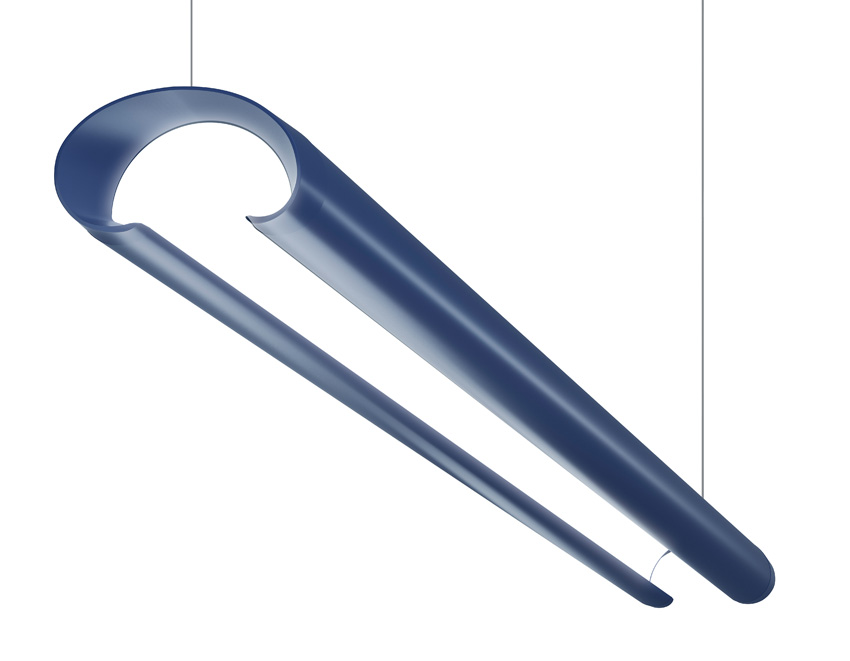
A veiled ambient direct/indirect pendant with no lens or seams in the reflector makes for a clean, continuous, unbroken line of light as far as the fixture extends.
How Does Veiled Ambient Measure Up?
The unique advantages of veiled ambient lighting appeal to each of the various roles involved in the process, from initial specs to end use. Architects appreciate the cleaner ceiling (thanks to fewer fixtures) and the soft essence of natural light. Lighting designers and engineers are thrilled about the excellent distribution of light and energy efficiency. Contractors are relieved to find that the fixtures are easier to install than traditional recessed, especially in hard ceilings—and maintenance teams like knowing there are no lenses to crack, fall out, or get dirty. Building owners welcome the cost savings from the lower fixture count and significantly lower energy usage. And end users are thrilled with the natural-feeling glow veiled ambient produces.
As in nearly every other aspect of life, technology is bringing convenience, control, and anywhere access to lighting—as well as opening up an entire new world of color possibilities.
Integerated Sensors and the Internet of Things (IOT)
The broadly used moniker IoT is used to describe everything from refrigerators that tell you when you’re out of milk to door locks you can activate from anywhere. Essentially, everything you control with buttons, switches, and dials now either has or will soon be accessible via the Internet.
LED has even impacted the advancement of lighting sensors since the fluorescent dimming ballast was exceedingly cost prohibitive. With LED, the capability is built in. Integrated sensors have moved leaps and bounds beyond the basic daylight harvesting and motion sensors of the past. Today’s integrated wall and ceiling sensors can now identify and adjust for both occupancy and daylight harvesting, manage HVAC systems, track employee movement throughout workspaces and far more.
The lighting application translates to more personalized, responsive, connected workspaces, and classrooms, driven by sensor technology and real-time data collection. Lighting is no longer simply on or off. Intelligent sensors are increasingly being embedded in the fixtures to acquire data regarding building use to ultimately be applied in ways that will improve the user experience.
LED and a Whole New World of Whites
As professionals in the design/build industry are acutely aware, white is complex, tricky—maddening even. Whether you’re working with paint or textiles, the nuances in color tone are seemingly endless and appear to change throughout the day as the natural light fluctuates morning to midday, and again in the afternoon and evening. White light has its own unique set of challenges—and now, some pretty incredible possibilities.
What do you picture when you think about white light? Direct sunlight at high noon? A glowing subway station? The warmth of a desk lamp? The truth is, it’s all of the above. White light is a bit of a catch-all for a range that includes a variety of shades, from cooler blue-whites to warmer golden-whites. The technical scale for this range is correlated color temperature (CCT), measured in Kelvin (K). White light’s practical spectrum runs from down around 2,200 K, which aligns with a dimmed incandescent lamp or similar light, to up above 8,000 K, which is comparable to bright noontime daylight.
While most traditional lighting sources emit light in just one color, LED is changing that—and fast.
In the early days of LED, hues were limited, and you simply committed to the warmer or cooler shade you felt best complemented the palette of each space. New fixtures can now emit shades across the full spectrum of white light, and the same fixture is equipped with chips that emit a slightly different hue depending on the model selected: from 2,700 K and 3,500 K all the way to up around 6,000 K.
Color Tuning
Now that the category has expanded to encompass a much broader array of subtleties and variations, designers and even the end users have far more control over color matching and, more importantly, color tuning, a breakthrough in controls made possible with LED. Color tuning is a new concept where multiple LED chips with a variety of color temperatures are combined into a single fixture, giving that fixture the ability to emit different colors of white light. If the warmer chips receive more of the power, the light will reflect that warmer white, and the opposite effect is achieved by directing power to the cooler chips. It’s even possible to adjust percentages to achieve a blended temperature as well.
White Light as Healer
While the aesthetic implications of white light tuning are certainly exciting in terms of design, the potential human physiological impact is even more intriguing. Not all classroom and office environments have access to daylight, and that’s where the beauty of tunable white light comes into play. Recent studies have indicated multiple potential positive implications for physical and mental health. The human body craves structure, relying on systems like the natural 24-hour circadian rhythm for physiological processes. Our bodies take their cues from these predictable patterns, such as changes in color temperature and intensity that happen naturally throughout the day. Separation from that pattern causes a disruption that has been linked to a variety of health concerns, including increased risk for cardiovascular issues, obesity, diabetes, and neurological problems like depression.
Incredibly, the built environment can now mimic the natural outdoor environment’s seasons and patterns, simulating daylight’s 24-hour cycle. As many more shades of white have become available, the hue of light can be adjusted throughout the day to mimic the sun’s typical progression. While still considered a somewhat emerging technology, tunable white light has shown positive indications in its ability to help those within these environments to maintain their healthier circadian rhythms. Practical applications range from keeping night-shift employees healthier to providing a calming influence in the classroom.
White Light in the Natural World
Take a look at how the color temperature of daylight progresses throughout the day. Between 6 a.m. and 9 a.m., daylight is often between 3,000 K and 4,000 K. By noon, the temperature of the daylight has increased to a brighter 5,000 K to 6,000 K. Color temperature then returns to the warmer-toned 3,000 K to 4,000 K range by mid to late afternoon. With white color tuning, LED fixtures can emit different shades of white light, mimicking the 24-hour cycle of natural light the human body is accustomed to following.
Full-Spectrum Color Tuning Ahead?
Because LED fixtures have the capacity to be designed to emit any number of different shades (red, blue, green, yellow, purple, etc.), the possibilities are truly astounding. With full color-tuning techniques that are currently in the works, environments have the potential to move from static to dynamic, freeing designers to experiment with an entirely new palette of creative expression. Immediately our minds jump to hospitality and entertainment applications like hotels, theaters, and stadiums; however, the commercial and institutional environments can benefit as well. Designers can visually highlight architectural accents or increase the vibrancy of art or materials, like the colors in a tapestry or painting. Retailers can make merchandise pop visually, and even grocers can make produce displays look more appealing with virtually unlimited degrees of customization.
Conclusion
For lighting designers and engineers, architects, and contractors, illumination is the last blank slate left, and a richly provocative canvas it is. LED innovation is burgeoning on multiple fronts, the potential applications continue to intrigue and inspire, and some of the industry’s greatest minds are intently focused on applying both physics and sheer artistry to reimagine the possibilities for built environments.
End Notes
1“Seven Challenges Lighting Designers Face When Using LEDs.” LEDinside. 20 March 2014. Web. 13 July 2017. www.ledinside.com/showreport/2014/3/seven_challenges_lighting_designers_face_when_using_leds.
2“Lighting & Productivity.” Lighting Design Lab. Web. 13 July 2017. www.lightingdesignlab.com/resources/articles/articles-lighting-productivity/lighting-productivity.
3“LED Shelf Light.” Steelcase. Web. 13 July 2017. www.steelcase.com/products/lighting/led-shelf-light/#features.
4Burns, John. “The focus on efficacy is hurting the lighting industry.” LEDs Magazine. 21 October 2016. Web. 13 July 2017. www.ledsmagazine.com/articles/print/volume-13/issue-8/features/last-word/the-focus-on-efficacy-is-hurting-the-lighting-industry.html.
Rob Empfield is a marketing professional and continuing education presenter at Prudential Lighting engaged in advancing the specification process for the lighting industry.
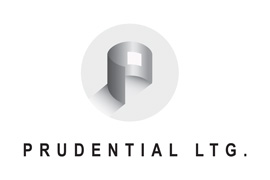
|
Manufacturing in Los Angeles since 1955, Prudential Lighting continues to create a wide range of fixtures, from elegant pendants to innovative LED luminaires, while collaborating with designers in realizing their visions for architectural lighting environments. Light creates life. Create with Prudential Lighting. www.prulite.com |

